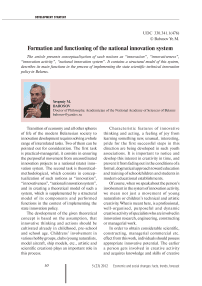Formation and functioning of the national innovation system
Автор: Babosov Yevgeniy Mikhaylovich
Журнал: Economic and Social Changes: Facts, Trends, Forecast @volnc-esc-en
Рубрика: Development strategy
Статья в выпуске: 5 (23) т.5, 2012 года.
Бесплатный доступ
The article presents conceptualization of such notions as “innovation”, “innovativeness”, “innovation activity”, “national innovation system”. It contains a structural model of this system, describes its main functions in the process of implementing the state scientific-technical innovation policy in Belarus.
Короткий адрес: https://sciup.org/147223395
IDR: 147223395 | УДК: 330.341.1(476)
Текст научной статьи Formation and functioning of the national innovation system
Transition of economy and all other spheres of life of the modern Belarusian society to innovation development requires solving a whole range of interrelated tasks. Two of them can be pointed out for consideration. The first task is practical-managerial, it consists in ensuring the purposeful movement from uncoordinated innovation projects to a national (state) innovation system. The second task is theoretical-methodological, which consists in conceptualization of such notions as “innovation”, “innovativeness”, “national innovation system”, and in creating a theoretical model of such a system, which is supplemented by a structural model of its components and performed functions in the context of implementing the state innovation policy.
The development of the given theoretical concept is based on the assumption, that innovative thinking and actions should be cultivated already in childhood, pre-school and school age. Childrens’ involvement in various hobby groups, clubs (young naturalists, model aircraft, ship models, etc., artistic and scientific creation) plays an important role in this process.
Characteristic features of innovative thinking and acting, a feeling of joy from learning something new, unusual, interesting, pride for the first successful steps in this direction are being developed in such youth associations. It is important to notice and develop this interest in creativity in time, and prevent it from fading out in the conditions of a formal, dogmatical approach toward education and training of schoolchildren and students in modern educational establishments.
Of course, when we speak about the person’s involvement in the system of innovation activity, we mean not just a movement of young naturalists or children’s technical and artistic creativity. What is meant here, is a professional, well-organised, purposeful and dynamic creative activity of specialists who are involved in innovation research, engineering, constructing or managerial work.
In order to obtain considerable scientific, constructing, managerial commercial etc. effect from this work, individuals should possess appropriate innovative potential. The earlier a person gets involved in creative activity and acquires knowledge and skills of creative thinking and action (in the process of personality development in schools and universities), the more developed and creative this innovative potential will be.
It is essential not to suppress the elements of innovative thinking and action that a person obtained in his/her school and college years, these elements should be developed, they should acquire more specific, professionally outlined ways of their manifestation in day-today activity in any sphere of economy, culture, health care, education, science, management. In this connection, conceptualization of the basic notions of innovative potential of a personality and social community, which include the terms “innovation”, “innovativeness” becomes more acute.
While accepting the fundamental importance and significance of introducing innovations in the production of new goods and services in order to achieve economic, social and other types of effect, we note, that innovation as a process of forward-looking creative activity should be understood and interpreted in a broader social context.
First of all, in the processes of young people’s education and upbringing, starting from kindergarten and school age, it is necessary to form the innovative potential in a personality and social community. We can formulate the definition of this social phenomenon on the basis of definitive approach. Innovative potential of a personality (social group, organization) is the integration of innovation capacity, innovation readiness, innovation capabilities and innovative action, implemented in real innovation activity. The main peculiarity of this phenomenon lies in the fact that innovative potential crystallizes in the act of making an innovative decision, which, in turn, becomes a trigger for an innovative action. This understanding implies that innovation in the sociological discourse should be conceptualized as a notion, reflecting the creative nature of social activities, oriented towards the generation of new ideas and changing the object of action to a new qualitative state. Therefore, the social phenomenon under consideration can be determined as follows: innovation is the creation of new technologies and technical novelties (based on new ideas and scientific knowledge), their embodiment in new kinds of commodity products and services, contributing to the growth of their efficiency and fulfillment of various consumer demands, as well as social processes’ improvement.
This interpretation provides for defining the main characteristics of innovation. They are:
-
a) target-oriented nature of innovation activities;
-
b) novelty of obtained results (ideas, methods, technologies, products, etc.), i.e. their qualitative difference from previous analogues;
-
c) completeness and practical applicability of obtained results;
-
d) increase of the competitiveness of personnel trained in education system, manufactured goods and services, and receiving benefits from their positioning on internal and external markets;
-
e) obtaining a more profound economic, social, ecological, scientific-technical, educational, social, cultural and managerial effect.
The above-stated peculiarities of innovation lead to the conclusion that it can develop from a “sprout” (a new idea or scientific discovery) to a creative process of innovation activity leading to practical implementation of obtained new results in the form of new technologies, technical facilities, design and engineering only when a favoufable innovation climate is created in a society and there exists a fairly high demand for innovations.
This second key notion of the issue under consideration can be conceptualized as follows. Innovativeness is the ability and willingness of a social system (scientific institution, enterprise, firm, sector, region, country) to integrate the latest achievements of science, engineering, technology, management, to commercialize scientific discoveries and development for sustainable innovative scientific-technical and socio-economic development and efficient management.
The main aspects of innovativeness consist in the following:
-
1. Capability to generate new ideas and research projects, to protect the intellectual property rights, to provide all economic entities with unrestricted access to the market of high technologies.
-
2. Ensuring the outrunning growth of investments in intellectual capital development, the impetus towards its involvement in implementing the latest scientific achievements in the economy and other spheres of society.
-
3. Embodiment of innovative ideas and actions in the innovation culture of an individual and of the community, which, in its practical implementation, gives a sustainable innovative character to all transformations taking place in a society.
-
4. Inclusion into innovation activity of all social mechanisms (existing in a scientific
-
5. Saturation of a society, its economic, healthcare, educational, administrative, etc. structures with innovation information, without which it becomes difficult to carry out innovation activity in the conditions of an information society.
-
6. Implementation of a targeted personnel policy, oriented toward the development of creative thinking and action among various categories of workers in all the spheres of life.
-
7. Priority development of high-tech industries, which requires substantial investments at the expense of budgetary and extrabudgetary funds, including foreign investment funds.
-
8. Development of innovativeness according to the “snowball” principle, when innovation processes in one sphere of life cause wave-like “resonance” emergence and spreading of innovations in other segments of society (fig. 1) .
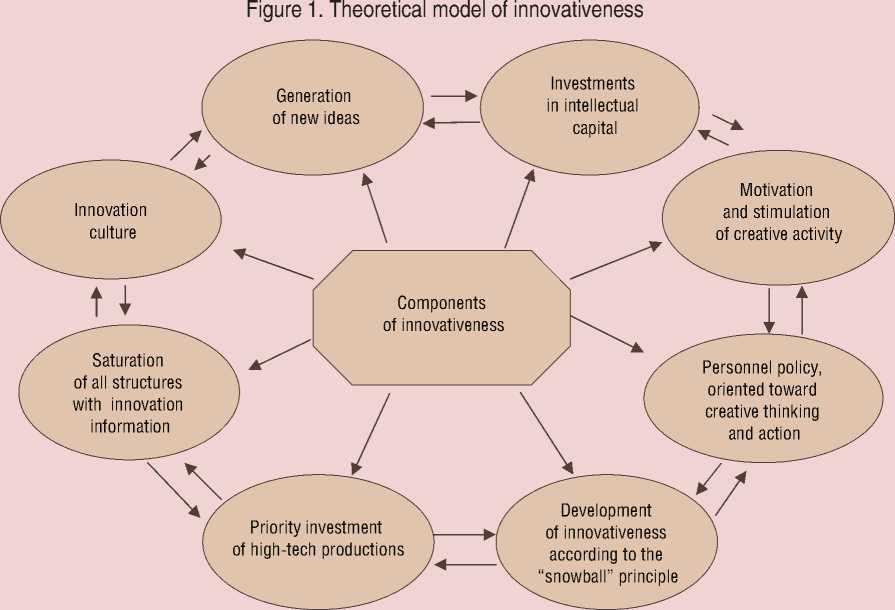
institution, enterprise, firm, region, and industry) motivating, stimulating and even compelling people to innovative actions.
Careful and thorough consideration of two basic conceptualized notions of innovation potential (referred to an individual, group, or society in general), proves that though, in the beginning, the leading role in innovation activity belongs to creative scientific elite and engineering-technical workers, mainly, construction personnel, this activity can’t result in high-efficiency products or services without active involvement of managers, entrepreneurs (including farmers), workers and peasants, i.e. all the categories of economically active social groups.
Each social group, solving their everyday problems, promotes the sustainable socioeconomic development of a country to a greater or lesser degree. And efficient solving of these tasks requires conditions and opportunities for substantial and well-paid work, satisfaction of material and spiritual needs, provision of citizens’ public and personal security;
development of healthcare, education, science, culture; development of friendly psychological and socio-political climate in a society. The path of a country’s innovation development is based on the intercrossing of these and other social variables. The involvement of various social strata of a society in sustainable innovation development can be presented in the theoretical model (fig. 2) .
Such a diversity of social subjects (individuals, social groups, organizations), included in innovation activity and possessing different needs, interests, preferences, attitudes, etc., leads to the fact that innovative process is characterized by nonlinearity, uncertainty, risk and unpredictability. It has to be acknowledged that, in recent years, a lot of new ideas, technologies and new, including importsubstituting, products have appeared in scientific institutions and universities, in design organizations and enterprises in Belarus; but
Figure 2. Model representing involvement of the main social strata in the process of sustainable innovation development
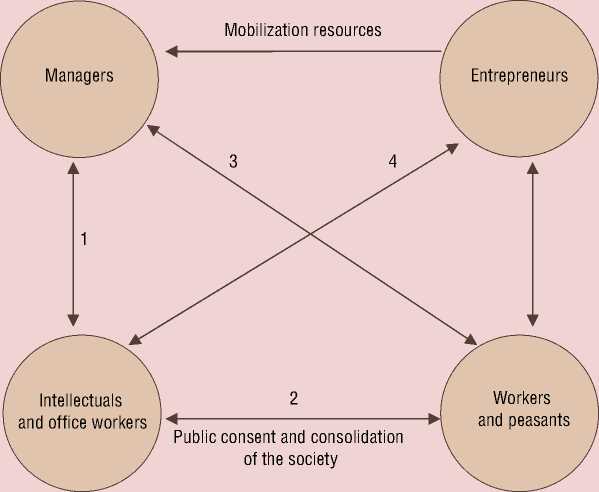
Figures in the arrows denote: 1 – level of education and competence of employees; 2 – labor and consumption; 3 – level of income; 4 – political stability
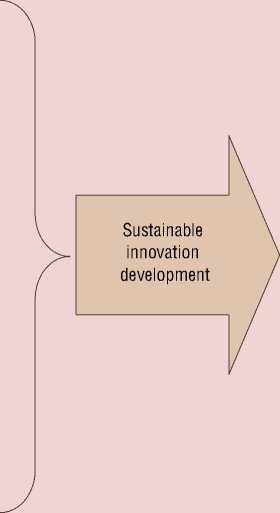
an integral and efficient national innovation system in education has not been formed yet. Unfortunately, the set of effective mechanisms identifying, supporting and distributing the best examples of innovation activity has not been properly organized yet. To achieve this goal, it is necessary to take a number of interrelated measures, aimed at creating high susceptibility to innovations among the personnel of education sphere, scientific and design organizations, industrial enterprises. Such susceptibility includes cognitive, motivational, technical and organizational readiness to the perception of innovations and their implementation in production activity. Cognitive readiness for innovations perception is manifested in the desire to receive detailed information on innovative technological and technical development and use them actively in their own practice of production activity. Motivational readiness for this kind of action reveals itself in the recognition of importance and prospects of economically promising innovations, which can be used in everyday activity. Technological readiness for innovations perception is manifested in using a wide range of information sources and channels concerning innovation-based approaches and research in various spheres of activity (media, Internet, seminars, discussions, conferences, etc.). Organizational readiness for innovations perception and acceptance is revealed in purposeful activities of search for and estimation of innovations, as well as in making decisions concerning their practical development in research, technological, managerial activities.
Promotion of the readiness of an enterprise’s or institution’s personnel for innovation activity is inextricably linked to the realization of the employees’ need for innovation and to the creation of innovation culture. Innovation culture of an employee is a system of heuristic qualities, typical of creative personalities; these qualities are manifested in various ways and forms of innovation activities carried out in research, educational, production, management, etc. processes. Innovation culture is based on: the thesaurus of innovation problems; object-subject fundamentals of innovation activity, i.e. a set of methods and techniques that provide an employee’s innovation activity, first of all, comprehensive and creative methods. Only an engineer, designer, manager, researcher and any other employee with a sufficiently high level of innovation culture, is capable of understanding an emerging innovative problem, and finding adequate ways and methods of its solution.
Formation of creative thinking, which is a core of innovation culture, doesn’t represent its total volume but should be complemented by the transition to the formation of innovative goals, as well as the ability and willingness to implement these goals in practical teaching and educational activity. But in order to make this transition from ideas to practical actions, it is necessary to develop and use the social mechanisms of overcoming the socio-psychological barriers to the successful development of innovations and their implementation. Such barriers are numerous, the main ones include:
-
• lack of awareness of enterprises’ heads and their employees concerning the modern, first of all innovative trends of development in science, education and production;
-
• low innovative potential of the microenvironment in the majority of scientific-research and educational institutions and production enterprises;
-
• lack of reliable social mechanisms of distribution of innovative ideas and their implementation in the production activity;
-
• lack of creative thinking and actions among many workers in all spheres of activity;
-
• lack of such components of innovative activity as cognitive, motivational, reflexive, design, etc. among many organizations’ heads.
Overcoming the above-mentioned social and psychological barriers that hamper the formation and development of innovation activity becomes an urgent need and a powerful factor in the development of innovative qualities of employees in different spheres.
But for successful formation and use of such qualities in everyday professional life it is necessary to establish a national (state) innovation system. This system represents a complex of social institutions and organizations with different forms of ownership, interacting in the process of generating new scientific ideas, in personnel training. These institutions should possess developed innovative potential and innovation culture, production, transfer and realization of innovative products and carry out their activities in the framework of the state scientific-technical and innovation policy.
This innovation system has a multicomponent structure, its constituents fulfill a number of interrelated functions. The structural model of the system is represented in figure 3 .
Figure 3. Structural model of the national innovation system
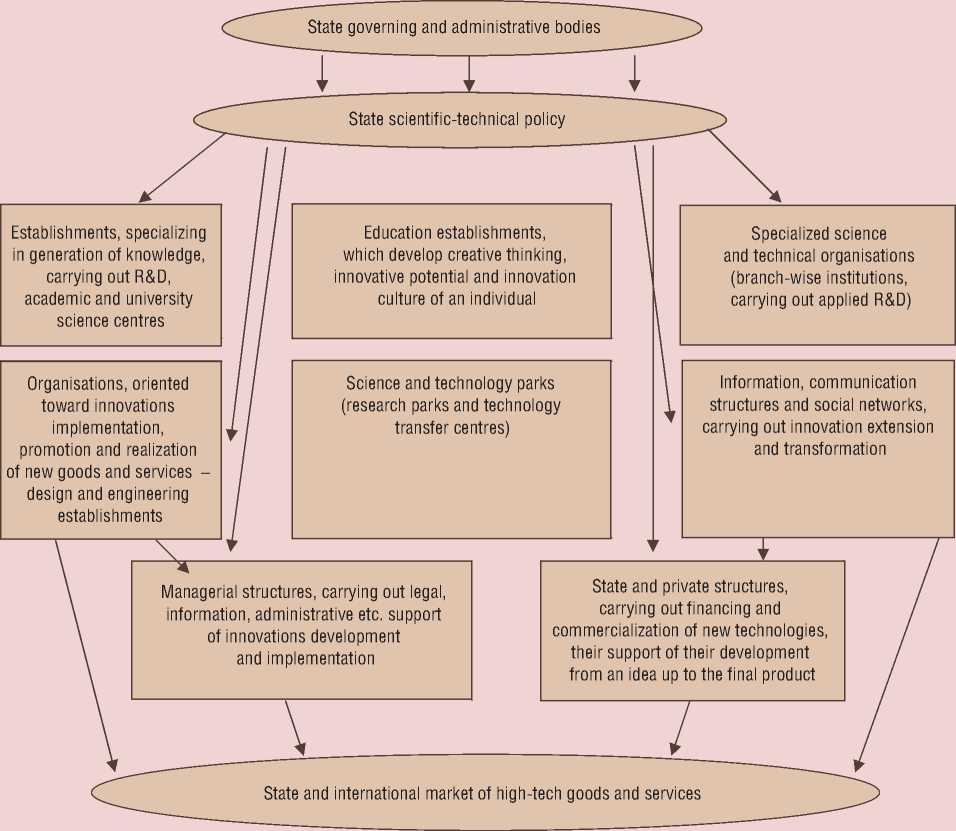
Figure 4. Priority tasks of innovation policy of a state
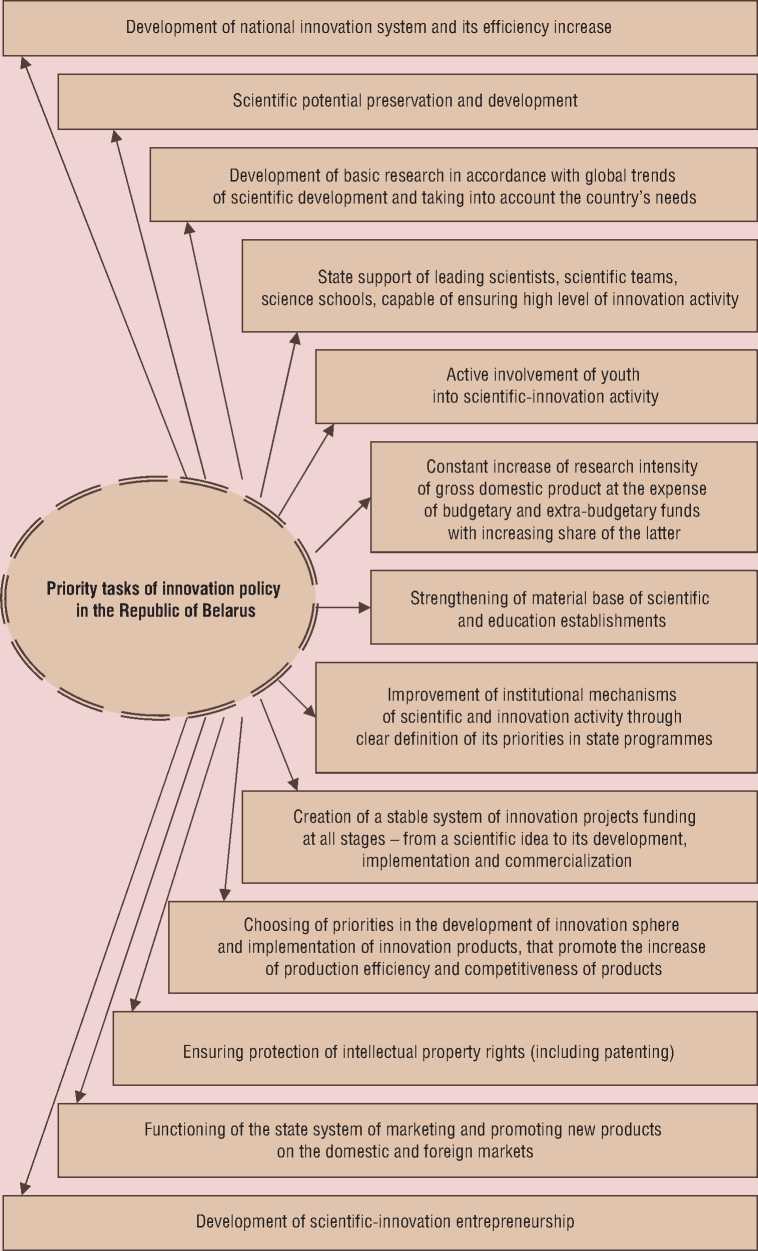
The structure of the national innovation system is smoothly interrelated with its functions. The most important of them are the following:
-
1. Formation and implementation of state scientific and technical policy as a guide for all its structural elements and carried out functions.
-
2. Definition of priorities in the field of scientific research and development, innovation activity.
-
3. Development and functioning of the regulatory-legislative base, creating a fair and equal social space for innovation activity.
-
4. Mobilization and concentration of human, financial, material-technical, organizational resources needed for the unfolding of innovative processes.
-
5. Stimulation of effective innovation activity.
-
6. Support of the development of new high-tech industries and agricultural production, construction and services.
-
7. Development of small innovation business, creation of small and medium-sized innovation enterprises and organizations.
-
8. Support of innovative processes with information resources.
In order to acquire a more specific character, these goals should be concentrated in different variants of strategic management of innovations, a crucial role in the implementation of which belongs to innovation policy, the main tasks of which are shown in figure 4.
In order to gain the desired effect from practical implementation of all the components of innovative strategy, it is necessary to solve a number of interrelated tasks. The following two are the most important of them. The first one is to increase motivation on all the stages of innovations implementation, starting with the development of new ideas and ending with the introduction of new technical and technological development results in the production of qualitatively more advanced products and services, attractive for consumers. The second and even more ambitious target is to carry out a qualitative shift in actual increase of innovation susceptibility of the enterprises. Indeed, the most important point concerning innovations is to make sure that an economy receives and absorbs them, making them into an actual innovative product. Only in this case the economy will become innovation, and its development will be sustainable.
Список литературы Formation and functioning of the national innovation system
- Babosov Ye.M. Creation and operation of an effective innovation system -a powerful foundation of a country’s sustainable development. In: Sociological essays of sustainable development of modern Belarus. Minsk, 2011.
- Babosov Ye.M. Innovation management and its constructive role in the conditions of financial-economic crisis. In: Sociology of management. 6th ed. Minsk, 2010.
- Myasnikovich M.V. Innovation activity in the Republic of Belarus. Minsk, 2004.
- National innovation system and state innovation policy of the Russian Federation. Moscow, 2009.
- National innovation system of the Republic of Belarus. Minsk, 2007.

